

For Parents & Educators. Parents How can parents model and thereby teach their kids healthy coping skills?
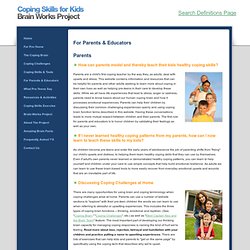
Parents are a child's first coping teacher by the way they, as adults, deal with upsets and stress. This website contains information and resources that can be helpful for parents and other adults seeking to learn more about coping in their own lives as well as helping pre-teens in their care to develop these skills.
While we all have life experiences that lead to stress, anger or sadness, parents need to know basics about our human coping brain and how it processes emotional experiences. Parents can help their children by discussing their common challenging experiences openly and using coping brain function terms described in this website. If I never learned healthy coping patterns from my parents, how can I now learn to teach these skills to my kids? Discussing Coping Challenges at Home There are many opportunities for using brain and coping terminology when coping challenges arise at home.
Educators 1. 2. Breathing with the diaphragm. Diaphragmatic breathing is the healthiest way of breathing and is a first step in normalising your breathing in order to manage anxiety or panic symptoms.
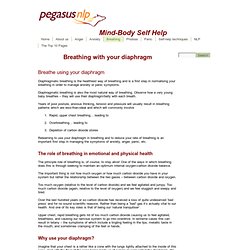
Diaphragmatic breathing is also the most natural way of breathing. Observe how a very young baby breathes – they will use their diaphragm/belly with each breath. Years of poor posture, anxious thinking, tension and pressure will usually result in breathing patterns which are less-than-ideal and which will commonly involve Rapid, upper chest breathing… leading toOverbreathing… leading toDepletion of carbon dioxide stores. Coping Skills. Digi puppet_1. Send a Flower Garden - zefrank. Garden - zefrank. Create Your Own Flowers on zefrank. Kaleidoscope. Quotes. Meditation_flower_zefrank. Fun Online Stress Relievers - Online Stress Reliever Games.
I’m a fan of online games for stress relief for those who enjoy them. They’re convenient, they can take your mind off of stress for a few minutes, and they’re generally free. The downside with some of them is that they can be addictive, taking up more time than they should and causing additional stress in the long run! If you need a quick distraction and would like to get into a more relaxed frame of mind but only want to spend a few minutes at it, I recommend the following ‘online toys’ from ZeFrank. 1.
Meditation Flowers This interesting game allows you to sing, chant, or drone your own sounds and, in response, interesting graphics appear on screen. 2. If you like (or at least can tolerate) vintage Beastie Boys, this one’s really cool. 3. 4. I love this one! 5. Top 25 Stress Relievers - 25 Ways to Relieve Stress. Music for Relaxation and Stress Relief. Better Sleep - Healthy Habits for Better Sleep. How To Reduce Stress and Become More Centered With Simple Karate Breathing Meditation. Meditation is a powerful stress reliever.
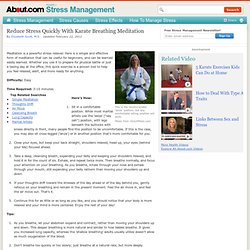
Here is a simple and effective form of meditation that can be useful for beginners, and can be learned easily learned. Whether you use it to prepare for physical battle or just a taxing day at the office, this quick exercise is a proven tool to help you feel relaxed, alert, and more ready for anything. Yoga and Stress - The Benefits of Yoga for Stress Management. Yoga for Stress Relief: Dating back over 5000 years, yoga is the oldest defined practice of self development. The methods of classical yoga include ethical disciplines, physical postures, breathing control and meditation. Traditionally an Eastern practice, it’s now becoming popular in the West. In fact, many companies, especially in Britain, are seeing the benefit of yoga, recognizing that relaxed workers are healthier and more creative, and are sponsoring yoga fitness programs.
Progressive Muscle Relaxation (PMR) - How to Reduce Tension with Progressive Muscle Relaxation (PMR) Benefits of Meditation - The Benefits of Meditation for Stress Management. Overview of Meditation: Throughout the day, when we experience stress, our bodies automatically react in ways that prepare us to fight or run.
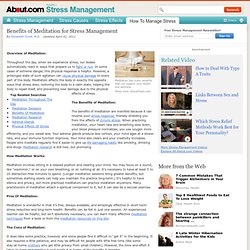
In some cases of extreme danger, this physical response is helpful. However, a prolonged state of such agitation can cause physical damage to every part of the body. Journaling - The Benefits of Journaling for Stress Management. Updated December 15, 2014.
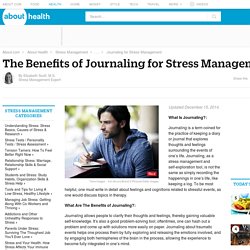
Journaling is a term coined for the practice of keeping a diary or journal that explores thoughts and feelings surrounding the events of one’s life. Journaling, as a stress management and self-exploration tool, is not the same as simply recording the happenings in one’s life, like keeping a log. To be most helpful, one must write in detail about feelings and cognitions related to stressful events, as one would discuss topics in therapy. Using Self Hypnosis for Stress Management. Overview Of Hypnosis: Hypnosis is perhaps one of the least understood therapeutic tools in use.
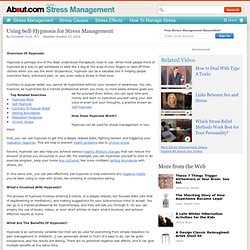
While most people think of hypnosis as a way to get somebody to bark like a dog at the snap of your fingers or take off their clothes when you say the work ‘stupendous’, hypnosis can be a valuable tool in helping people overcome fears, withstand pain, or, yes, even reduce stress in their lives. Contrary to popular belief, you cannot be hypnotized without your consent or awareness. You can, however, be hypnotized by a trained professional whom you trust, to more easily achieve goals you set for yourself. Even better, you can save time and money and learn to hypnotize yourself using your own voice or even just your thoughts, a practice known as ‘self-hypnosis’. How Does Hypnosis Work?
How To Use Guided Imagery For Relaxation and Stress Management. Guided Imagery is a convenient and simple relaxation technique that can help you quickly and easily manage stress and reduce tension in your body.

It’s virtually as easy as indulging in a vivid daydream and, with practice, this technique can help you to better access your inner wisdom. Here's how to get started with guided imagery: Difficulty: Easy Time Required: 10-15 Minutes Here's How: Get into a comfortable position, like one you would use for meditation or self-hypnosis. Tips: You may want to use ambient sounds that compliment your imagery. Visualization - How To Use Visualization For Stress Relief. There are numerous effective ways to use visualization to relieve stress.
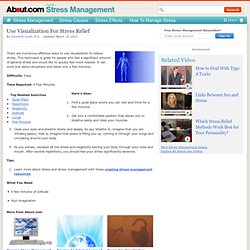
This technique is great for people who feel a significant amount of general stress and would like to quickly feel more relaxed. It can work just about anywhere and takes only a few minutes. Guided Imagery - Using Guided Imagery for Stress Management. Guided Imagery’s Effects on the Body: Guided imagery has been found to provide significant stress reduction benefits, including physically relaxing the body quickly and efficiently and even helping participants get in touch with deeper levels of wisdom (held on a subconscious level) that would help them better manage their lives in ways that would reduce stress.

The studies demonstrating the health benefits of imagery are so numerous that many hospitals are incorporating imagery as an option to help with treatment. What’s Involved? : With the help of an imagery tape, a professional helper, or just one’s imagination, those who practice guided imagery get into a deeply relaxed state and envision, with great detail relating to all of the senses, a relaxing scene.
What Are the Pros? Imagery can provide relaxation, insight and wisdom. Nibbles - Challenges of Parenting. Nibbles - Family Stress. Life Stress. Systematic Stress Management from the American Institute of Preventive Medicine - Life Events Questionnaire. Afterdeployment.org. Deep Breathing for Kids : Help Children Learn to Destress. Deep breathing for kids has many benefits.
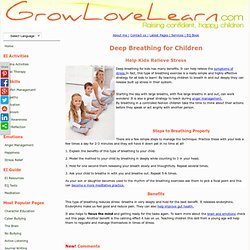
It can help relieve the symptoms of stress.In fact, this type of breathing exercise is a really simple and highly effective strategy for all kids to learn! By teaching children to breath in and out deeply they can release built up stress in their system. Starting the day with large breaths, with five large breaths in and out, can work wonders! It is also a great strategy to teach during anger management. By breathing in a controlled fashion children take the time to think about their actions before they speak or act angrily with another person. Steps to Breathing Properly There are a few simple steps to manage the technique. 1. 2. 3. 3. Emotional Clearing Training.
BODY LEVEL: To say this program gets you deeply relaxed is an understatement. If you have any stress or anxiety from the day, from ongoing issues, or even about this work, you'll be taken to a place where negativity vanishes. You'll find yourself floating on an energy wave, deep into the dreamy, soft, right-brain, transcending the negative left-brain lower-self, supported and soothed by my voice, the music, and the entrainment technology. If feelings from the subconscious do emerge, don't be afraid of them or try to make them go away. Stress Symptoms : What are the Signs of Stress in Kids?
What are some common stress symptoms in children? They can vary from person to person. It is important to learn to recognize the symptoms in children and also to teach kids to recognize the symptoms themselves. Here is a list of common signs of stressful feelings: Migraines or HeadachesNauseaHeartburn and IndigestionLoss of AppetiteChest PalpitationsConstipation or DiarrheaStomach crampsShaking of the bodyMuscle spasmsEczema / Psoriasis that flares upHigher levels of sweatingPoor ConcentrationFunny Tummies Teaching your child to recognize the symptoms in themselves is an excellent skill. Yoga Blog. Do you ever wish you could just get in a pose, hang out for a while, feel great while doing it and even better when you are through?
Inner Child Stress Relief Strategies: Top 10 Stress Relief Strategies For Your Inner Child. As kids, certain stress relief strategies came naturally. As adults, however, we may have forgotten how to relieve stress, and find ourselves consumed by it. Life Stress - How To Stop Life Stress Before It Becomes Severe.
We all know what it feels like to be overwhelmed by stress, and this site has many techniques that can effectively reduce high levels of stress to more manageable levels so you don’t suffer negative health consequences. However, the best way to manage severe stress is to prevent it, or catch it while it’s still low-grade stress and prevent it from becoming severe and chronic. This article contains some important suggestions that have also been recommended by the Mayo Clinic on how to manage stress day-by-day to prevent it from becoming overwhelming.
Relaxing It’s important to keep your mind and body relaxed. Meditation, prayer, having a creative outlet, listening to music and laughter all help. Relaxation Techniques and Tension Tamers: Stress Management Techniques To Help You Feel Better Quickly. Stress Relievers - 25 Stress Relievers to Try. Live Your Life Well: iPhone Live Happy app. Live Your Life WellSM is proud to partner with Signal Patterns, developers of psychology-based Web and mobile applications. Signal Patterns, which comprises a team of 20 PhDs worldwide, has just released the Live HappyTM iPhone application. This first-of-its-kind mobile happiness-boosting program guides users through a set of daily activities that research indicates can boost both short- and long-term happiness. Live Happy was developed by Signal Patterns’ SP Labs team using key elements of the extensive behavioral research of Dr. Sonja Lyubomirsky. Stress Managment - An Online Workshop - Hillsborough County Extension.